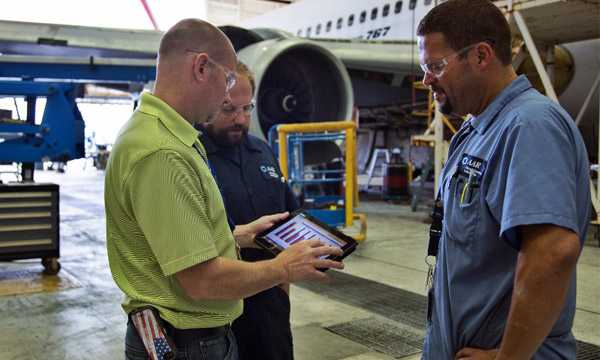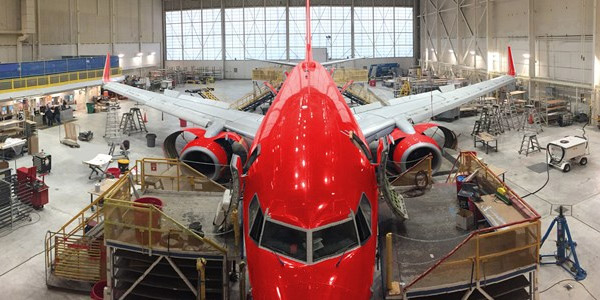MRO: AAR's maintenance activities at full capacity
Romain Guillot
 le 23/05/2019 , Maintenance aéronautique le 23/05/2019 , Maintenance aéronautique
AAR Corporation is the largest independent MRO operator in the Americas, with almost 19 hectares of hangars across five main sites in the United States (Indianapolis, Miami, Oklahoma City, Duluth and Rockford). The maintenance company has also been expanding internationally for the last two years, purchasing two sites in Canada, at Trois-Rivières (Quebec) and Windsor (Ontario), adding nearly 27 000 m2 of additional hangars.
AAR is showing that its appetite for commercial aircraft maintenance activities isn't limited to the American continent, with the creation of the future Indian MRO centre which is due to open in Nagpur this year, in cooperation with Indamer. Le Journal de l'Aviation met Brian Sartain, Senior Vice President Repair and Engineering Services at AAR and took the opportunity to look over all of the group's commercial heavy maintenance activities.
Growth slowed down by labour shortage
The growing maintenance requirements would of course enable AAR to develop more, but, like many others in the sector, the MRO company is experiencing major labour issues in the United States. For Brian Sartain, the problem is particularly acute when it comes to experienced mechanics. "A significant number of our employees are now between 55 and 60 years old and they're starting to retire", he explains. He also mentions the fact that mechanics are now more drawn to jobs in the manufacturing sector. "For our activities in Indianapolis for example, GE has built a brand new factory to produce its LEAP engines just one hundred kilometres from our hangars, and newly-qualified mechanics are heading to the engine manufacturer first, because salaries are significantly higher there, driven by the major backlog in engines".
Fortunately this isn't the case everywhere and AAR is continuing to grow significantly in Miami, for example, as there is a major pool of qualified labour in Florida.
 AAR's mechanics using the StAAR digital tool. Picture © AAR AAR's mechanics using the StAAR digital tool. Picture © AAR
Whatever the case, Brian Sartain intends to keep looking on the bright side and doesn't see this problem lasting for long, as AAR has obviously been able to anticipate and has also invested significantly in training or assistance programmes. For example, this is the case for the "Eagle Pathway" initiative, which enables mechanics to have part of their training paid in exchange for a commitment to work for a set period, for two or three years for example. AAR has also established links with several local universities to create sourcing channels to reach candidates while they are still at high school. They will then be steered towards AMT (Aviation Maintenance Technician) training and will be able to join AAR as apprentices with degrees validated by AAR.
"The labour problem will be sorted out within the next 18 to 36 months, but the difficulty is that we also have needs right now, which means we need to pay large amounts of money to attract talent, for example through recruitment agents, to enable us to continue to grow" .
Heavy maintenance the priority
Over the last two years, the three large American airlines have been launching major programmes to modernise their aircraft cabins, and AAR of course has skills in this area. But Brian Sartain thinks that this isn't the activity which will enable AAR to reach the customer directly since the company really specialises in heavy maintenance. "We have some fantastic and very solid customers; Southwest Airlines, Air Canada, Alaska Airlines, Delta and United. When these customers have cabin modification programmes and when they coincide with their major inspections then yes, we can offer them a packaged offer".
He also recalls that cabin modification lines are less labour-intensive than heavy maintenance lines. "When we consider our hangar surfaces and how precious they are to us in terms of working hours, then of course a modification line is not a very effective activity", he emphasises. "However, if a customer comes in for a major inspection and I can modify their cabin at the same time or just after, then they save money and so do we".
The cherry on the cake for Brian Sartain is when AAR can also produce composite modification kits thanks to its specialist centre located in Florida. "We also offer a complete solution and we want to move more towards this type of offer".
Brian Sartain also looked back over AAR's Canadian activities following the purchase of two Premier Aviation centres, "two centres which are starting to fill up thanks to our strong relationship with Air Canada". He specifies that these facilities are of course available for other operators, but that its activities are mainly devoted to meeting the requirements of the major Canadian airline which wanted to continue to maintain its aircraft within its own borders. Of course, they were affected recently by the worldwide grounding of the Boeing 737 MAXes, but their activity should "pick up nicely again once the aircraft are authorised to fly once more".
 A Boeing 737NG during a maintenance check in Indianapolis. Picture © AAR
A Boeing 737NG during a maintenance check in Indianapolis. Picture © AAR
As to whether the arrival of new generation all-cargo narrow body aircraft such as the Boeing 737-800F, which is soon to be in service in the United States, could be an area for development, Brian Sartain reminded us that the MRO company doesn't carry out aircraft conversions but that its hangers regularly host freighters for heavy maintenance. However, he doesn't see this activity as becoming a growth accelerator as it represents a relatively low percentage of major inspections. "Today, we have eleven simultaneous dedicated maintenance lines for Southwest and six for Alaska Airlines, so we just don't have any extra capacity for now, but if there are any opportunities then of course we'll take them" .
AAR is also one of the six initial partners of the Airbus MRO Alliance (AMA) which was unveiled in June 2017, even if Brian Sartain concedes that the alliance membership rules have not been fully established. "Generally speaking, we see this alliance as way to share our best practice and it is an opportunity which may ultimately make life easier for our customers" .
Maintenance data working for customers
The American MRO has started creating digital tools, in particular for repair management, such as Airvolution for components or StAAR to manage job cards or maintenance actions. This second tool has also been sold to other actors in the sector. AAR has also started prototyping "remote mechanic" type solutions, using drones for airframe inspection or augmented reality to train mechanics or make their work easier. And like all the other major actors, AAR of course wants to analyse its data.
"We are the largest MRO company in North America and we deal with over a thousand aircraft each year. All the data we collect, whether when removing and replacing specific parts, and the associated costs, enable us to have a big data approach and this will create added value proposals for our customers", explains Brian Sartain.
"We think that this is the next major step, and it's what our customers want" .
|